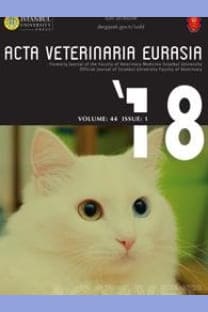Impact of Veterinary Vaccines on Human Health and Probable Challenges
___
Adams, L. G., Khare, S., Lawhon, S. D., Rossetti, C. A., Lewin, H. A., Lipton, M. S., Turse, J. E., Wylie, D. C., Bai, Y., & Drake, K. L. (2011). Enhancing the role of veterinary vaccines reducing zoonotic diseases of humans: Linking systems biology with vaccine development. Vaccine, 29(41), 7197–7206. [CrossRef]Azuaje, F., Zheng, H., Camargo, A., & Wang, H. (2011). Systems-based biological concordance and predictive reproducibility of gene set discovery methods in cardiovascular disease. Journal of Biomedical Informatics, 44(4), 637–647. [CrossRef]
Baurley, J. W., Mcmahan, C. S., Ervin, C. M., Pardamean, B., & Bergen, A. W. (2018). Biosignature discovery for substance use disorders using statistical learning. Trends in Molecular Medicine, 24(2), 221–235. [CrossRef]
Berkelman, R. L. (2003). Human illness associated with use of veterinary vaccines. Clinical Infectious Diseases, 37(3), 407–414. [CrossRef]
Bermejo, A. V., Nielsen, K. N., & Holst, P. J. (2021). Translational oncology comment on: Endogenous retroviruses expressed in human tumours cannot be used as targets for anti-tumour vaccines. Translational Oncology, 14(5), 101040. [CrossRef]
Brauer, R., & Chen, P. (2015). Influenza virus propagation in embryonated chicken eggs. Journal of Visualized Experiments, 97(97), 1–6.[CrossRef]
Bruckner, L. (2010). Viral safety and extraneous agents testing for veterinary vaccines: Rationale for requirements, the European approach. Biologicals, 38(3), 338–339. [CrossRef]
Denner, J. (2021). Endogenous retroviruses expressed in human tumours cannot be used as targets for anti-tumour vaccines. Translational Oncology, 14(1), 100941. [CrossRef]
Dewannieux, M., Ribet, D., & Heidmann, T. (2010). Risks linked to endogenous retroviruses for vaccine production: A general overview. Biologicals, 38(3), 366–370. [CrossRef]
Fisher, B. L. (2014). Human illness associated with use of veterinary vaccine. (Available at: https://www.nvic.org/cmstemplates/nvic/pdf/ live-virus-vaccines-and-vaccine-shedding.pdf)
Francis, M. J. (2017). Vaccination for one health. International Journal of Vaccines and Vaccination, 4(5), 4–6. [CrossRef]
Gombold, J., Karakasidis, S., Niksa, P., Podczasy, J., Neumann, K., Richardson, J., Sane, N., Johnson-Leva, R., Randolph, V., Sadoff, J., Minor, P., Schmidt, A., Duncan, P., & Sheets, R. L. (2014). Systematic evaluation of in vitro and in vivo adventitious virus assays for the detection of viral contamination of cell banks and biological products. Vaccine, 32(24), 2916–2926. [CrossRef]
Hayes, M., Whitesell, M., & Brown, M. A. (2013). Pathological and evolutionary implications of retroviruses as mobile genetic elements. Genes, 4(4), 573–582. [CrossRef]
Ishida, Y., Zhao, K., Greenwood, A. D., & Roca, A. L. (2015). Proliferation of endogenous retroviruses in the early stages of a host germ line invasion. Molecular Biology and Evolution, 32(1), 109–120. [CrossRef]
Kuleš, J., Horvatić, A., Guillemin, N., Galan, A., Mrljak, V., & Bhide, M. (2016). New approaches and omics tools for mining of vaccine candidates against vector-borne diseases. Molecular Biosystems, 12(9), 2680–2694. [CrossRef]
Lee, N. H., Lee, J. A., Park, S. Y., Song, C. S., Choi, I. S., & Lee, J. B. (2012). A review of vaccine development and research for industry animals in Korea. Clinical and Experimental Vaccine Research, 1(1), 18–34. [CrossRef]
Miyazawa, T. (2010). Endogenous retroviruses as potential hazards for vaccines. Biologicals, 38(3), 371–376. [CrossRef]
Parrino, J., & Graham, B. S. (2006). Smallpox vaccines: Past, present, and future. Journal of Allergy and Clinical Immunology, 118(6), 1320–1326. [CrossRef]
Pastoret, P. P. (2010). Human and animal vaccine contaminations. Biologicals, 38(3), 332–334. [CrossRef]
Polak, M. P., Antos, A., Rola, J., & Żmudziński, J. F. (2016). Viral shedders in a herd vaccinated against infection with bovine viral diarrhoea virus (BVDV) without prior testing for the presence of persistently infected animals. Journal of Veterinary Research, 60(4), 379–384. [CrossRef]
Roth, J. A. (2011). Veterinary vaccines and their importance to animal health and public health. Procedia in Vaccinology, 5, 127–136. [CrossRef]
Sheridan, S., & Coughlin, J. (2010). Comparison of requirements in the European Union and United States of America for pre-clinical viral safety testing of veterinary vaccines. Biologicals, 38(3), 340–345. [CrossRef]
Wisher, M. (2002). Biosafety and product release testing issues relevant to replication-competent oncolytic viruses. Cancer Gene Therapy, 9(12), 1056–1061. [CrossRef]
- ISSN: 2618-639X
- Yayın Aralığı: 3
- Başlangıç: 1975
- Yayıncı: İstanbul Üniversitesi-Cerrahpaşa
İSMAİL ÇETİN, Deniz BELENLI, Derya YEŞİLBAĞ, Firdevs KORKMAZ TURGUD, Doğan NARİNÇ
Nadiah Jafar ALI, Sabri Mohd YUSOFF, Polycarp Nwunuji TANKO, Nadirah Abu NOR, Opeyemi Onilude MAYOWA
Histomorphological Examination of Skin Wound Healing Under the Effect of Avocado Oil in Wistar Rats
Mohammad Reza EBAD SICHANI, Mehdi FARID, Elham MOGHTADAEI KHORASGANI
Sana FERROUDJ, Ali ELAFRI, Ismahen HALASSI, Toufik BENSABER, Meftah BOUTAFGHA
16S Bacterial Metagenomic Analysis of Herby Cheese (Otlu Peynir) Microbiota
Mert SUDAĞIDAN, Mediha Nur Zafer YURT, Behiye Büşra TAŞBAŞI, Elif Esma ACAR, Esra ERSOY ÖMEROĞLU, Samet UÇAK, VELİ CENGİZ ÖZALP, Ali AYDIN
Hamza Doğan ÖZİVGEN, Yalçın AKBULUT
Gizem ÇUFAOĞLU, BAHAR ONARAN, Görkem CENGİZ, NAİM DENİZ AYAZ, MUAMMER GÖNCÜOĞLU
Impact of Veterinary Vaccines on Human Health and Probable Challenges
Md. Mehadi Hasan SOHAG, Yahia CHEBLOUNE
Alla YEMELYANENKO, Mykola CHORNOZUB, Nataliia KOZII, Olexander EMELIANENKO, Liydmula STOVBETSKA, Oksana POROSHINSKA, Volodymyr SHAHANENKO, Vasyl KOZIY
